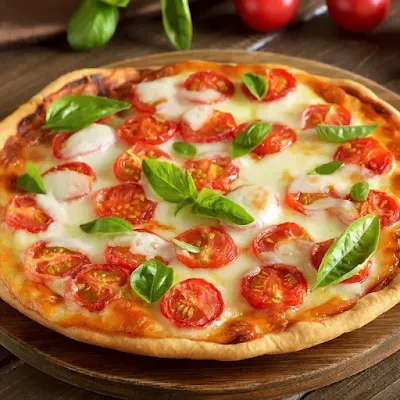1. Pizza Margherita
Definition: A classic Italian pizza made with a thin crust topped simply with tomatoes, mozzarella cheese, and basil, representing the colors of the Italian flag.Origin: Italy, specifically Naples.
History: Created in 1889 by a Neapolitan chef in honor of Queen Margherita of Savoy. He topped the pizza with red tomatoes, white mozzarella, and green basil to represent the Italian flag.
Spread: Now popular worldwide, Pizza Margherita is a staple of Italian cuisine and has become iconic in pizzerias across the globe.
Ingredients:
- Dough: 500g flour, 300ml water, 7g yeast, 10g salt.
- Toppings: 250g mozzarella cheese, 3-4 ripe tomatoes or 200g tomato sauce, fresh basil leaves, salt, and olive oil.
- Mix flour, water, yeast, and salt to form a smooth dough. Let it rise for about 1-2 hours.
- Roll out the dough into a circle, spread the tomato sauce, and add slices of mozzarella.
- Bake in a preheated oven at 250°C (480°F) for about 10 minutes.
- Garnish with fresh basil leaves and drizzle with olive oil before serving.
2. Sushi
Definition: Japanese dish consisting of vinegared rice combined with various toppings or fillings, such as raw fish, vegetables, and seaweed.Origin: Japan.
History: Originally developed as a way to preserve fish by fermenting it with rice. Modern sushi evolved during the Edo period (1603-1868) and took on various forms like Nigiri and Maki.
Spread: Sushi has become internationally popular, with sushi bars and restaurants common in major cities worldwide.
Ingredients:
- Sushi rice: 2 cups short-grain rice, 2 cups water, 2 tbsp rice vinegar, 1 tbsp sugar, 1 tsp salt.
- Fish: 200g fresh salmon or tuna.
- Other: Seaweed (nori), vegetables (e.g., cucumber, avocado), soy sauce, wasabi, and pickled ginger.
- Rinse and cook the rice, then season it with vinegar, sugar, and salt.
- For Nigiri, shape the rice into small ovals and top with a slice of fish.
- For Maki, place rice and ingredients on a sheet of nori, roll, and cut into bite-sized pieces.
3. Tacos
- Definition: Mexican dish consisting of small tortillas filled with various ingredients, typically including meat, onions, and fresh herbs.
- Origin: Mexico.
- History: Tacos date back to pre-Columbian times, documented as early as the 18th century. They were originally a practical way to wrap and enjoy food with tortillas.
- Spread: Tacos are now a popular street food worldwide, especially in the United States and Latin American countries.
- Ingredients:
- Tortillas: 10 small corn or flour tortillas.
- Filling: 500g grilled meat (e.g., beef, chicken, or pork), diced onions, cilantro, lime wedges, and salsa.
- Preparation:
- Grill or cook the meat, seasoned with salt, pepper, and chili.
- Warm the tortillas, then fill each one with meat and top with diced onions and cilantro.
- Add salsa and a squeeze of lime juice for extra flavor.
- Serving and Eating: Served open-faced, allowing diners to fold them. They are enjoyed by hand, often with a variety of spicy sauces.
4. Pad Thai
- Definition: A popular Thai stir-fried noodle dish, typically featuring rice noodles, tofu or shrimp, eggs, and a flavorful sauce.
- Origin: Thailand.
- History: Pad Thai became a national dish in the 1930s as part of a government campaign to promote Thai cuisine and reduce rice consumption.
- Spread: Pad Thai has become a global favorite, found in Thai restaurants around the world.
- Ingredients:
- Noodles: 200g rice noodles.
- Sauce: 3 tbsp fish sauce, 1 tbsp tamarind paste, 1 tbsp sugar, 1 tbsp soy sauce.
- Additional Ingredients: 200g shrimp or chicken, 2 eggs, bean sprouts, green onions, crushed peanuts, lime wedges.
- Preparation:
- Soak the noodles in warm water until soft.
- Stir-fry shrimp or chicken with garlic, push to one side, and scramble eggs on the other side.
- Add noodles and sauce, tossing until well coated.
- Add bean sprouts and green onions before serving.
- Serving and Eating: Served hot on a plate, garnished with crushed peanuts and lime wedges. Pad Thai is eaten with a fork and spoon, blending sweet, sour, and savory flavors.
5. Croissant
- Definition: A buttery, flaky pastry of Austrian origin, now a French classic, with layers of dough and butter rolled and folded multiple times.
- Origin: France, inspired by Austrian pastries.
- History: The croissant was influenced by the Austrian "kipferl" and became popular in France in the 19th century, evolving into the classic buttery pastry it is today.
- Spread: The croissant is now a staple in bakeries worldwide, especially in Western countries.
- Ingredients:
- Dough: 250g flour, 125ml milk, 25g sugar, 5g salt, 7g yeast.
- Butter Layer: 150g cold butter.
- Preparation:
- Prepare the dough, allowing it to rise, then roll and fold with the butter multiple times to create layers.
- Cut the dough into triangles, roll into crescent shapes, and let them rise again.
- Bake at 200°C (390°F) for 15-20 minutes until golden brown.
- Serving and Eating: Served fresh and warm, croissants are enjoyed by hand, often accompanied by coffee. Variations may include fillings like chocolate or almond cream.
These dishes are beloved not only in their countries of origin but have spread globally, each representing unique cultural and culinary traditions that have captivated taste buds around the world







No comments